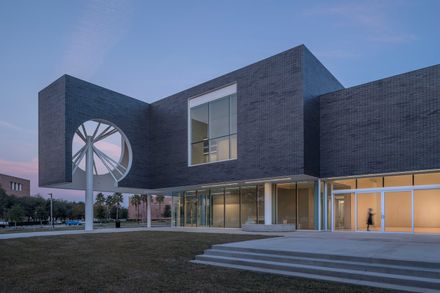
Moody Center for the Arts
PHOTOGRAPHS
Nash Baker, Thomas Struth
MANUFACTURERS
Endicott, Herman Miller, Herman Miller , Hightower
LIGHTING DESIGN
Horton Lees Brogden Lighting Design
CIVIL ENGINEER
Walter P. Moore & Associates
STRUCTURAL ENGINEER
Guy Nordenson and Associates, Cardno
CONTRACTOR
Linbeck
ACOUSTIC ENGINEER
Nagata Acoustics
GEOTECHNICAL ENGINEER
Ulrich Engineers
AV/ IT/ SECURITY
Rice University
MICHAEL MALTZAN
Michael Maltzan, Tim Williams, Jeanette Fabry, Andrea Manning, Matt Austin, Hiroshi Tokumaru
PROJECT TEAM
Peter Erni, James Tate, Ann Soo, Jen Lathrop, Gee Ghid Tse, Pil Sun Ham, Alan Sillay, Peter Osborne, Collin Cobia, and Casey Benito
MECHANICAL, ELECTRICAL, PLUMBING, SUSTAINABILITY
Stantec
THEATER PLANNING & DESIGN
Fisher Dachs Associates
WATERPROOFING
Wiss, Janney, Elstner Associates
INTERIOR SIGNAGE
Michael Maltzan Associates
TOTAL COST
$30 million
FIRE AND LIFE SAFETY
Jensen Hughes
LEED CERTIFICATION
Silver
AV
Rice University
LEADERSHIP
Suzanne Deal Booth, Alison Weaver
IT
Rice University
SECURITY
Rice University
FIRE & LIFE SAFETY
Jensen Hughes
LOCATION
Houston, United States
CATEGORY
University
Text description provided by architect.
The Moody interior is intended to create a sense of openness and possibility. Sightlines transect through spaces, creating layered views of the myriad activities taking place within the building’s production, instructional and exhibition spaces.
Views extend simultaneously along major corridors and out to the campus, providing an easy orientation point for visitors, students and faculty and facilitating direct access to studios, classrooms and shops.
Extensive interior glazing offers views into learning, production and exhibition spaces to highlight the experience of the artistic process as a complement to the exhibition of finished works.
Along the building’s north façade a set of wide stairs rises from the first floor and turns back toward the Moody’s interior, creating an interior amphitheater that serves as an informal social space.
The emphasis on transparency extends to the building’s exterior, with floor-to- ceiling glass along the majority of the first floor elevations.
Arcades created by the second floor’s cantilevered massing create shaded walkways that make the building’s brick-clad upper story appear to levitate.
Large picture windows punctuate the articulated brick façade in a playful rhythm and bring light deep into interior spaces. The design deftly incorporates aspects shared by many of Rice’s buildings.
Pedestrian paths cut across the site’s open lawn and into the building, simultaneously organizing key interior program areas and linking the new building to the broader campus.
The design creates an iconic home for Rice’s new arts center in the spirit of the Moody’s forward-looking vision that is equally at home on the University’s historic campus.
Three signature Lanterns hover over the ground plan. Two are located at each end of the northern arcade, supported by the iconic "Starburst" columns.
A third lantern houses the Moody’s coffee lounge. Illuminated from within at night they will become a collection of new beacons for Rice University.
The first floor of the Moody features the Lois Chiles Studio Theater, a 150-seat Studio Theater for performing arts and its support spaces; the skylit Brown Foundation Gallery and central gallery for exhibitions and experimental performances; two media art galleries;
Creative Open Studio; and an interdisciplinary maker lab that includes a wood shop, metal shop, paint booth, rapid prototyping areas and a student classroom. Outside the Brown Foundation Gallery is an outdoor projection wall.
The second floor features a break-out area, three classrooms (one of which doubles as an open studio); a large module studio, an artist’s studio, a technology lending library, audiovisual editing booths and a café. Offices and other administration spaces are also on this floor.

















